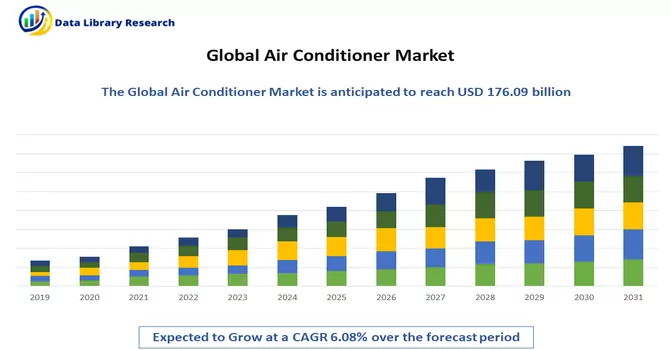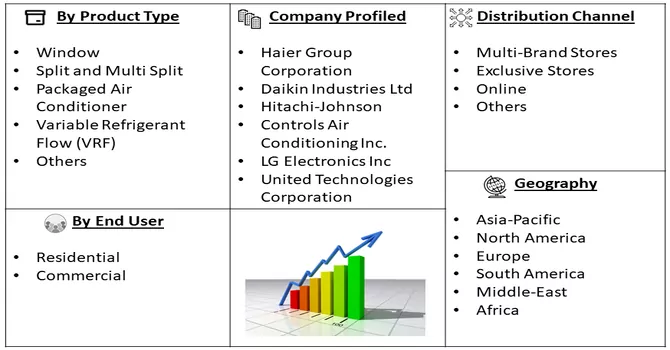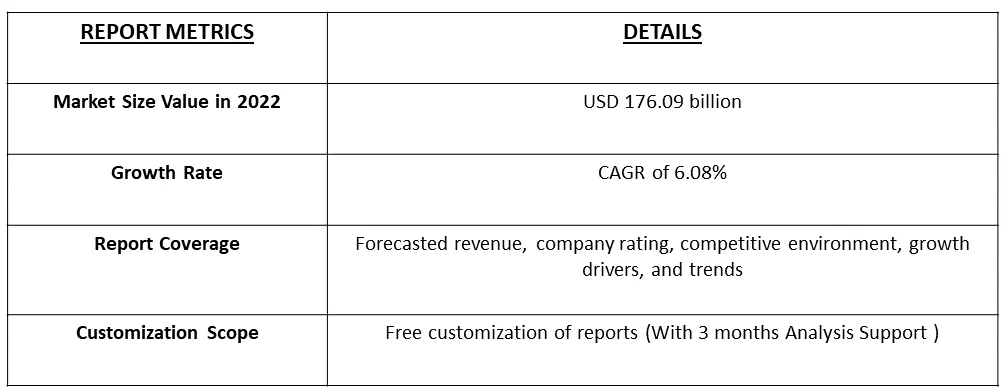The Air Conditioner Market size is estimated at USD 176.09 billion in 2023, and is expected to register a CAGR of 6.08% during the forecast period (2023-2030).

Get Complete Analysis Of The Report - Download Free Sample PDF
An "air conditioner" is a mechanical device or system used to regulate and control the temperature, humidity, and overall air quality within an enclosed space, typically a room, building, or vehicle. It works by removing heat from the air and transferring it outside, thereby cooling and dehumidifying the indoor environment. Air conditioners are commonly used for comfort and climate control in homes, offices, factories, and various other indoor settings. They come in different types, including window units, split systems, central air conditioning systems, and portable units, each designed to serve specific cooling needs.
The air conditioning (AC) industry is poised for substantial growth, primarily driven by increasing global temperatures and humidity levels. Moreover, air conditioners are no longer considered luxury items but essential utilities, further boosting market demand. The introduction of advanced AC units, including inverter technology and air purification features, is expected to have a favorable impact on the air conditioner market in the foreseeable future.
Market Segmentation: The Global Air Conditioner Market is Segmented By Product Type (Window, Split and Multi Split, Packaged Air Conditioner, Variable Refrigerant Flow (VRF) and Others (Chillers and Portables)), Distribution Channel (Multi-Brand Stores, Exclusive Stores, Online, and Other Distribution Channels), End User (Residential and Commercial), and Geography (North America, South America, Europe, Asia-Pacific, and Middle-East And Africa). The report provides the market sizes and forecasts in terms of value in USD billion.

For Detailed Market Segmentation - Download Free Sample PDF
There is a growing emphasis on energy-efficient air conditioning solutions. Consumers and regulations are driving the demand for environmentally friendly AC systems that consume less energy and use refrigerants with lower global warming potential. Moreover, the market is witnessing a surge in smart air conditioners that can be controlled remotely via smartphones or integrated with home automation systems. These systems offer greater convenience and energy management.
Market Drivers:
Rising Global Temperatures and Urbanization and Population Growth
Global temperatures have been steadily climbing due to climate change, leading to more frequent and severe heatwaves. As a result, the demand for air conditioning systems has surged. People seek refuge from scorching temperatures, especially in regions prone to extreme heat. For instance, an article published by Frontiers in August 2022, reported that an empirical analysis of panel data from 28 provinces in China from 2006 to 2018, and that study reported that examines the increase in climate change-induced temperature changes on the urbanization of China’s population. Thus, increase in global temperature demands for an increase in air conditioning devices, thereby driving the growth of the studied market.
Technological Development
Technological advancements in air conditioning systems have significantly improved their efficiency, performance, and functionality. These developments are driven by the need to reduce energy consumption, enhance user comfort, and address environmental concerns. For instance, in June 2020, Daikin Industries, Ltd. announced the establishment of a joint venture with WASSHA Inc. The joint venture developed a new company, Baridi Inc., to provide air conditioning systems on a subscription basis for the people of the United Republic of Tanzania. Moreover, inverter-driven compressors have become more prevalent in air conditioners. These compressors adjust the speed and capacity of the system based on the cooling demand, resulting in higher energy efficiency and more precise temperature control. Thus, the market is expected to witness significant growth over the forecast period.
Market Restraints :
Environmental Issues Associated with Air Conditioners
Air conditioning systems are notable for their substantial energy consumption, particularly in areas with hot climates or during the peak summer season. This heightened energy usage results in elevated greenhouse gas emissions, thus contributing to the ongoing issue of global warming and its associated impacts on climate change. In certain scenarios, the heightened electricity demand during heatwaves can place an excessive burden on power grids, potentially causing outages and exacerbating environmental challenges.
The COVID-19 pandemic has had a significant impact on the use and management of air conditioning systems. The pandemic has heightened awareness about the importance of indoor air quality. Building owners and managers are focusing on improving ventilation and filtration systems to reduce the risk of virus transmission indoors. Many building owners have upgraded air conditioning systems with advanced air filtration and purification technologies, such as HEPA filters and ultraviolet germicidal irradiation (UVGI), to capture and deactivate viral particles in the air. Thus, the COVID-19 pandemic has led to a reevaluation of the role of air conditioning in indoor environments, with a focus on air quality, filtration, and ventilation. Many of these changes are likely to persist as a long-term response to the evolving understanding of airborne transmission and the importance of indoor air quality in public health.
Segmental Analysis :
Variable Refrigerant Flow (VRF) Segment is Expected to Witness Significant Growth Over the Forecast Period
Variable Refrigerant Flow (VRF) is an advanced and energy-efficient HVAC technology that has gained prominence in the heating and cooling industry. VRF systems offer precise control over the distribution of conditioned air, making them a popular choice for a wide range of applications, from residential buildings to large commercial complexes. VRF systems are not limited to cooling; they can provide both cooling and heating, making them suitable for year-round use. In heating mode, the system extracts heat from the outdoor air (or from the ground in some geothermal systems) and transfers it indoors. VRF systems are known for their quiet operation, both indoors and outdoors. This is especially important for maintaining comfort and reducing noise disturbances in residential and commercial settings. Thus, the segment is expected to witness significant growth over the forecast period.
Commercial Segment is Expected to Witness Significant Growth Over the Forecast Period
Commercial air conditioners are vital components of modern commercial spaces, providing comfortable and controlled environments for employees, customers, and occupants. Commercial air conditioners are specialized HVAC (Heating, Ventilation, and Air Conditioning) systems designed to provide efficient cooling and environmental control for large commercial spaces. These systems are crucial for maintaining comfort, productivity, and air quality in various commercial settings, from offices and retail stores to hospitals and industrial facilities. Commercial air conditioners often come with advanced diagnostic and monitoring features. These systems allow for proactive maintenance by providing real-time data on system performance and alerting building managers or technicians to potential issues. This reduces downtime and operational disruptions. Thus, owing to such advantages, the segment is expected to witness significant growth over the forecast period.
Multi-brand Stores Segment is Expected to Witness Significant Growth Over the Forecast Period
Multi-brand stores, often referred to as multi-brand retailers, are retail outlets that carry products from multiple brands, offering a wide variety of options to consumers in a single location. These stores can cater to a broad range of product categories, including electronics and appliances like air conditioners. Multi-brand stores are known for their extensive selection of products from various manufacturers. When it comes to air conditioners, these stores typically stock units from multiple brands, offering consumers a wide choice in terms of size, capacity, features, and price points. This diversity allows customers to compare different models and make informed decisions based on their specific cooling needs. Thus, the segment is expected to witness significant growth over the forecast period.
Asia-Pacific Region is Expected to Witness Significant Growth Over the Forecast Period
The Asia-Pacific region's demand for air conditioners is heavily influenced by its climate diversity, urbanization, economic growth, technological innovation, and increasing environmental awareness.
The Asia-Pacific region is a hub for technological advancements in the air conditioning industry. Manufacturers in countries like Japan, South Korea, and China are at the forefront of developing energy-efficient and innovative air conditioning technologies, including inverter-driven compressors and smart HVAC systems. For instance, in June 2021, Carrier announced the acquisition of a controlling stake in Guangdong Giwee Group (Giwee Group). The acquisition was aimed at expanding Carrier’s geographic footprint to enhance its market position. In addition to acquisitions, major players in the market also indulge in collaborations with local players to increase their products’ reach.
Many governments in the Asia-Pacific region have introduced policies and regulations aimed at promoting energy efficiency and reducing the environmental impact of air conditioning systems. These measures encourage the use of more efficient and environmentally friendly cooling technologies. Thus, the region is expected to witness significant growth over the forecast period.

Get Complete Analysis Of The Report - Download Free Sample PDF
The competitive landscape analysis provides a detailed strategic analysis of the company’s business and performance, such as financial information, revenue breakup by segment and by geography, risk analysis, key facts, company overview, business strategy, key product offerings, marketing and distribution strategies, new product development, and recent news. A few major players include:
Recent Developments:
1) In January 2022, LG Electronics USA showcased its new robust 2022 lineup of residential, light commercial, and commercial HVAC solutions at the 2022 AHR Expo conducted in Las Vegas.
2) In January 2021, Panasonic aimed to double its AC business in the next three years to invest in domestic manufacturing in India. The company, which introduced the HU series of ACs with the recently-announced nanoeX technology, is eyeing about 35% sales growth in the segment this year on the back of pent-up demand. According to the company, nanoeX technology releases hydroxyl radicals contained in water, which are also known as "nature's detergent" that are capable of inhibiting bacteria and viruses, including 99.99% of adhered novel coronavirus.
Q1. What was the Air Conditioner Market size in 2023?
The Air Conditioner Market size is estimated at USD 176.09 billion in 2023.
Q2. At what CAGR is the Air Conditioner market projected to grow within the forecast period?
Air Conditioner Market is expected to register a CAGR of 6.08% during the forecast period.
Q3. What are the factors driving the Air Conditioner market?
Key factors that are driving the growth include the Rising Global Temperatures and Urbanization and Population Growth and Technological Development.
Q4. Which Region is expected to hold the highest Market share?
Asia-pacific region is expected to hold the highest Market share.
Data Library Research are conducted by industry experts who offer insight on industry structure, market segmentations technology assessment and competitive landscape (CL), and penetration, as well as on emerging trends. Their analysis is based on primary interviews (~ 80%) and secondary research (~ 20%) as well as years of professional expertise in their respective industries. Adding to this, by analysing historical trends and current market positions, our analysts predict where the market will be headed for the next five years. Furthermore, the varying trends of segment & categories geographically presented are also studied and the estimated based on the primary & secondary research.
In this particular report from the supply side Data Library Research has conducted primary surveys (interviews) with the key level executives (VP, CEO’s, Marketing Director, Business Development Manager and SOFT) of the companies that active & prominent as well as the midsized organization
FIGURE 1: DLR RESEARH PROCESS

Extensive primary research was conducted to gain a deeper insight of the market and industry performance. The analysis is based on both primary and secondary research as well as years of professional expertise in the respective industries.
In addition to analysing current and historical trends, our analysts predict where the market is headed over the next five years.
It varies by segment for these categories geographically presented in the list of market tables. Speaking about this particular report we have conducted primary surveys (interviews) with the key level executives (VP, CEO’s, Marketing Director, Business Development Manager and many more) of the major players active in the market.
Secondary ResearchSecondary research was mainly used to collect and identify information useful for the extensive, technical, market-oriented, and Friend’s study of the Global Extra Neutral Alcohol. It was also used to obtain key information about major players, market classification and segmentation according to the industry trends, geographical markets, and developments related to the market and technology perspectives. For this study, analysts have gathered information from various credible sources, such as annual reports, sec filings, journals, white papers, SOFT presentations, and company web sites.
Market Size EstimationBoth, top-down and bottom-up approaches were used to estimate and validate the size of the Global market and to estimate the size of various other dependent submarkets in the overall Extra Neutral Alcohol. The key players in the market were identified through secondary research and their market contributions in the respective geographies were determined through primary and secondary research.
Forecast Model
